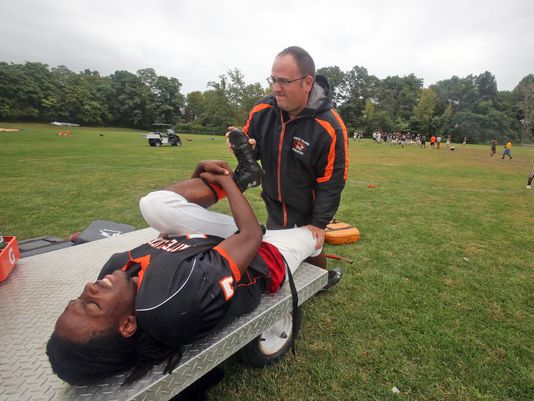
How many fingers am I holding up?
Thankfully, we’ve graduated from that Cro-Magnon test for concussions and put some knowledge into play. Athletic trainers have slowly become part of the high school landscape, and we have more of them on the sidelines in Section 1 than anywhere in the state.
It’s a movement worth celebrating.
And we get an opportunity to do just that Friday when Athletic Training Recognition Week gets under way. The initiative was started three years ago. It’s an opportunity for members of the New York State Athletic Trainers Association to educate the rub-some-dirt-on-it holdovers
These dedicated individuals are no longer a luxury.
“We’re lucky in Section 1 where 70 percent of the high schools have a full-time athletic trainer,” said Dave Byrnes, the Yorktown ATC who’s become a sideline fixture. “It’s likely due to demographics. There is more financial support, but I don’t think any school can justify not having one.”
Amen.
“Invaluable,” is how Mahopac athletic director John Augusta describes the contributions of Brenna Lape at the school. “It’s so much more advanced now, especially the concussion protocol. There’s injury prevention and injury rehabilitation. She puts in long, long hours, before during and after the games.”
According to the Korey Stringer Institute’s ongoing survey, only 27 percent of the high schools in New York State employ a full-time athletic trainer.
Talk about tempting fate.
Who do you want looking after your kids? I’m voting for the exemplary coach with perspective and passion working in concert with the dedicated advocate for health and wellness.
Many of the districts in Section 1 that do not employ a full-time athletic trainer are contracting services on a part-time basis.
Here’s a thought. If your high school is currently among the 5-10 percent without a certified athletic trainer on board, make a phone call. Ask for the logic.
Most districts spend in the neighborhood of $60,000 a year on athletic training.
“I’ve been doing this for 27 years, and there is not one negative,” said Carol Guzinski, the varsity ATC for North Rockland. “Parents, in general, are overjoyed with the care their kids are getting. Before, every single kid with an injury would have to go to the doctor and the school district would have to pay for that. Now we’re only sending kids who need to see a doctor.”
The job description for these folks is lengthy.
It’s virtually impossible to cover an entire campus so athletic trainers start each season by educating coaches on basics. There are injury evaluations and therapeutic exercises to conduct each day before practice or games.
“A lot of my time is spent on the phone with parents, therapists and doctors getting updates,” Guzinski said.
There’s any number of creaky ankles, elbows, knees and wrists that need taping after school. Sometimes a college intern stops by to help. And then it’s off to patrol the sidelines where they often keep an eye on both teams.
It’s a long day.
Guzinski is a willing confidante, as well, on call 24 hours.
“Sometimes a kid will not go to a coach with an injury because they’re afraid to lose playing time,” she noted. “Once they know my goal is to keep them in practice and keep them in games, they’re comfortable telling me there’s an issue. A lot of these kids have our phone numbers, they call us by our first names. It’s a more casual relationship.”
Byrnes also spends countless hours advocating for proper care and isn’t shy about speaking up when he sees a potentially dangerous situation.
“I certainly try to keep my emotions in check,” he said. “There are times I feel like I have to educate the officials, maybe open their eyes a little bit. I’m there to protect my players at all times.”
And they have so many peers around the state who match that level of dedication all year long.
None of them have ever diagnosed a concussion with fingers in the air. When athletes need more than a hand up or a kind word, let’s hope there’s a certified athletic trainer on site to dispense the necessary calm and compassion.
In an effort to recognize the efforts of athletic trainers in Section 1, we’re asking student/athletes to tweet a photo of their school’s ATC in action this week to @lohudsports and we’ll share them.
ORIGINAL ARTICLE:
http://www.lohud.com/story/sports/columnists/mike-dougherty/2015/10/07/handiwork-athletic-trainers-worth-celebrating/73539222/